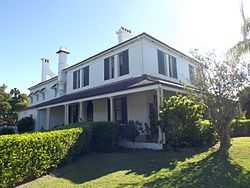Lota House
| Lota House | |
|---|---|
|
Building in 2015 | |
| Location | 162 Oceana Terrace, Lota, City of Brisbane, Queensland, Australia |
| Coordinates | 27°27′46″S 153°11′21″E / 27.4629°S 153.1892°ECoordinates: 27°27′46″S 153°11′21″E / 27.4629°S 153.1892°E |
| Design period | 1840s - 1860s (mid-19th century) |
| Built | 1865 - c. 1910 |
| Official name: Lota House - Edwin Marsden Tooth Memorial Home, Lota House | |
| Type | state heritage (built, landscape) |
| Designated | 21 October 1992 |
| Reference no. | 600247 |
| Significant period | 1860s-1910s (fabric, historical) |
| Significant components | trees/plantings, dairy/creamery, extension/s or addition/s, billiards room, driveway, tank - water (underground), natural landscape, garden/grounds, residential accommodation - main house, cellar |
 Location of Lota House in Queensland | |
Lota House is a heritage-listed villa at 162 Oceana Terrace, Lota, City of Brisbane, Queensland, Australia. It was built from 1865 to c. 1910. It is also known as Edwin Marsden Tooth Memorial Home. It was added to the Queensland Heritage Register on 21 October 1992.[1]
History
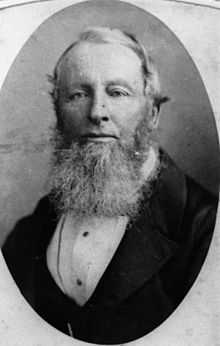
The earliest section of Lota House, a substantial two-storeyed rendered brick residence, was constructed in 1865-66 for Irish born Queensland squatter and politician William Duckett White, Member of the Queensland Legislative Council. The name commemorates the family home of his wife, Jane Simpson, in County Cork, Ireland.[1]
William and Jane White and their two children emigrated from Ireland to Sydney as assisted immigrants in 1840, and bought farm land on the Richmond River. Flood losses forced the family out of the Richmond and through 1842-43 White taught school in the Mangrove area north of Sydney until accepting an offer in 1844 to manage Beau Desert run in the Moreton Bay District for his cousin Joseph Phelps Robinson. Robinson died in 1848, following which his brother George and WD White raised the capital to purchase Beau Desert, one of the largest runs on the Logan. About 1857, WD White left Beau Desert under the management of his son, Albert William Duckett White, and William, Jane and their daughter Helena moved to Eagle Farm near Brisbane. On 26 April 1861 White was appointed to the Queensland Legislative Council, a position he held for over 19 years until 5 August 1880.[1]
WD White (later WD White & Son, then WD White & Sons) acquired considerable Queensland property. In addition to the Beau Desert holding, White took up three runs in the Gold Coast hinterland in the early 1850s: Tubber in 1852 and Murry Jerry and Dungogie runs acquired from AW Compigne in 1853. In 1867 he took up the lease of Pimpama and Cumboomba (or Coombabah) runs in the Beenleigh area but these were thrown open for selection in 1869, the lease lapsed, and in 1871 White acquired from Robert Towns the consolidated runs of Kerry, Sarabah, and Nindooinbah adjacent to Beau Desert. Much of Beau Desert was cut up for closer settlement in the 1860s and early 1870s, following which WD White & Son acquired the Bluff Downs holdings in the Kennedy District 1872-76. From 1882 the Whites were in partnership with the Collins family of Mundoolun on the Logan as White Collins & Co., and in the 1880s and 1890s this partnership, which survived for about a century, acquired several stations in northwest Queensland. Besides this pastoral empire, the Whites also held Beenleigh and Southport town properties and the Lota estate near Brisbane.[1]
Between 1860 and 1863 WD White acquired adjoining lands overlooking Waterloo Bay near Brisbane, to create a bayside property of about 350 acres. Approximately 200 acres (portions 79, 79A and 145, parish of Tingalpa) bounded by what is now Gannon Avenue to the north, Whites Road to the west, Hides and Orallo Streets to the south, and Waterloo Bay to the east, were acquired in WD White's name. Portion 90, the land lying to the south between Hides and Orallo Streets and Lota Creek, was acquired in the names of WD White, Robert Herbert (first Premier of Queensland) and John Bramston, but appears to have been worked as part of White's Lota estate from an early period.[1]
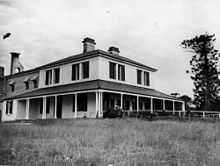
Lota House was erected on portion 79, comprising 153 acres purchased by White in November 1860 and transferred to him in January 1861. Brisbane architect Thomas Taylor called tenders for a villa residence at Lota in November 1865, the proprietor to provide the stone, brick, lime and timber. By June 1866 Taylor, architect to the Hon. William Duckett White was in debt[2] and White called the tenders for the plumbing and plastering work. The Whites are believed to have resided at Wyvernleigh (erected early 1860s, now demolished) on the adjacent Manly estate while Lota House was built, enabling WD White's close supervision of the construction. Lota House was completed by January 1867, when it was described by the White's son-in-law, Graham Mylne, as a grand, comfortable new house with large rooms, fresh breezes, and views over Moreton Bay.[1]
The entrance to Lota House faced south, but the principal rooms overlooked the bay to the east. A dairy was located on the southwest corner of the house, truncating the surrounding ground floor verandahs. The ground floor comprised a large entrance vestibule with drawing and dining rooms to the right, an office and staircase leading to the upper level on the right, a small sitting room at the end of the hall, next to which was a bootroom, and a pantry beneath the staircase, from which access to a cellar was gained. Upstairs comprised bedrooms and a dressing room. Servants' quarters and kitchen were located in a detached wing.[1]
The Whites developed their property as a country estate in the tradition of British landed gentry, and by the 1880s it was well established. A pair of big white gates flanked by Moreton Bay figs (located on what is now White's Road with a gatekeeper's lodge nearby) gave access to a curved drive leading through open grass paddocks to the house, which was surrounded by extensive gardens designed by Jane White. At the rear of the house a grassed courtyard separated it from stables, coachhouses, and haylofts opposite, and a detached kitchen wing and servants' quarters at right angles to the main building was connected to the house by a covered walkway. In the courtyard were two deep underground tanks, each covered with a large, circular cut stone, and from these rain water was pumped to the house, kitchen, stables and garden. Further to the west, on the slope behind the stables, were yards, cow bales, fowl houses and pig styes, as well as a hut accommodating South Sea Islanders working on the property. Cows and horses grazed in the paddocks surrounding the house, and maize, sorghum and hay were grown on the flats of Lota Creek as supplementary fodder. Like most of the farmers in the district, White probably grew sugar cane on the property. The estate ran down to the bay, where by the 1910s there was a boat-shed and jetty.[1]
The Whites often entertained at Lota House, and Governor Bowen and RGW Herbert were frequent visitors. Herbert not only was in partnership with White in some of the Lota land, but had acquired in his own name portions 88, 89 and 91, comprising at least 250 acres, to the west of White's Road.[1]
WD White was active in the local community, being one of the first members of the Bulimba Divisional Board established in 1879-80, a warden of the Tingalpa Anglican Church (now Christ Church, Tingalpa), and a Justice of the Peace. In 1867 he transferred the Lota estate (portions 79, 79A and 90) to his wife. When Jane White died in 1887 the estate passed to her son Albert William Duckett White of Bluff Downs, with life tenancy for her husband WD White. In 1890 the railways resumed some Lota land for the Cleveland railway line.[1]
Following William Duckett White's death in 1893 the house was rented to various tenants, during which time it fell into disrepair and the garden deteriorated. In 1908, WD White's grandson, William Duckett White (Duckett) acquired the property. Duckett had married in 1906 and on return from a world tour in 1908, he and his wife took up residence at Lota House, which they renovated and extended. The extensions were of timber and comprised a substantial two-storeyed wing at the rear incorporating kitchen and laundry on the ground floor and service stairs leading to a school room, spare bedroom, two bathrooms and servants' quarters on the upper floor; a single-storeyed day nursery on the west corner of the downstairs verandah; a separate billiard room to the northwest of the house; and a covered way and bush house roofed with wooden slats between the billiard room and the main house. Brisbane architect Claude William Chambers called tenders for the work in September 1908. At this time, the 1865-66 dining and drawing rooms were redecorated by the Sydney firm Beard Watsons with ornate timber mantelpieces (replacing earlier white marble) and new wallpapers and carpets. Duckett White also subdivided the estate, with land sales starting from 1911, and the grounds surrounding Lota House were reduced to just under 10 acres. The pine trees lining the driveway from Oceana Terrace to the front of the house most likely were planted at this period.[1]
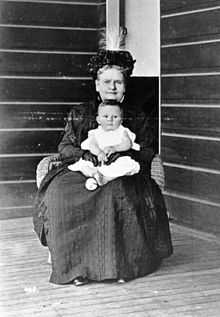
WD White's daughter Helena had married a Capt Graham Mylne and their son Graham Ernest Mylne purchased Lota House from his cousin Duckett White in 1913. The Mylnes took up residence in October 1913, but title to the property was not transferred until April 1914. Graham was general manager of White Collins & Co. from 1913 to 1942, and his wife Kathleen was prominently involved with the Queensland Country Women's Association. The Mylnes resided at Lota House until Graham's death in 1958, following which the family sold the property to the Anglican Church in late 1960.[1]
To fund the purchase the Church utilised a legacy from Sir Edwin Tooth combined with a government subsidy, and on 27 July 1963 Lady Tooth opened Lota House as the Edwin Marsden Tooth Memorial Home providing accommodation for the aged. Three accommodation blocks were erected on the property at that time, and several new facilities were opened in 1991. At this time, the covered way, bushhouse and part of the former billiard room (now a chapel) were removed to accommodate a large dining room. In the early 1990s the main building was refurbished. Lota House remains the property of the Anglican Church and still functions as aged accommodation.[1]
In the mid-1980s the Friends of EM Tooth Memorial Home were founded. Although this voluntary group is largely concerned with the welfare of the home's residents, the Friends are also keenly interested in the history and heritage of the place and were involved with its recent refurbishment.[1]
The remnant eucalypt woodland on the southeast and southwest perimeters of the property has been associated with Lota House from the earliest establishment of the estate. The woodland, which extends over the cliff along The Esplanade, forms a landmark in the Lota area and has been entered in the Brisbane City Council's Brisbane Conservation Atlas (prepared in the 1980s and 1990s) for its high biological and scenic values. In 1992 this woodland was subject to a BCC Vegetation Protection Order for its high scenic and landscape value.[1]
Description
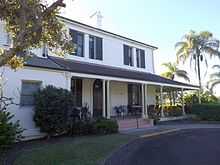
Lota House is a two-storeyed rendered brick building with timber extensions, which stands on the crest of a hill rising up from The Esplanade at Lota, on the shores of Moreton Bay. The house overlooks the bay to the northeast. Between the house and the bay is a strip of eucalypt woodland which runs along the cliff to The Esplanade, and then returns along a gully by the southeast boundary.[1]
The site is grassed with a scattering of eucalypts, particularly in the southeastern corner which is the subject of a Brisbane City Council Vegetation Protection Order. There is a variety of large planted trees including a fig, camphor laurels, and particularly a bunya pine, on the northwestern side of the house. The present access to the site is by a curving bitumen driveway lined with pine trees from Oceana Terrace to the southwest, which terminates at the entry to the house. To the south side of the drive is a timber garage with a gabled corrugated iron roof.[1]
Through the site is a series of single-storeyed accommodation buildings for the aged which have been constructed since the acquisition of the property by the Anglican Church. These buildings are not considered to be of cultural heritage significance. Linking these buildings are covered ways which run across the northeastern and northwestern elevations of the house.[1]
At present, the lower level of the original part of Lota House is used for activities for the residents, hairdressing, and a small office space under the stair. The upper level is the residence of the Superintendent and her family which extends into the southwest extension. The rear section of this level is for overnight staff accommodation. The lower level of this wing houses the kitchen and some store areas. The northwest wing is the new Dining Room and the Chapel.[1]
The original section of Lota House is a two-storeyed rendered brick building with characteristics demonstrating Georgian influence. The entry to the house is from the circular driveway to the southeast, but the principal facade is the symmetrical northeastern face addressing the bay. The hipped roof of the house and the verandah roof are both of slate. At each end of the roof is a moulded brick chimney. The upper level single-pane sashed windows and ground level French doors have louvred cedar shutters on unusual iron rails and recessed tracks which slide to close. It has a wide concrete verandah to three sides, with a colonnade of turned timber posts of Tuscan order, paired either side of the entry, and as a triplet to one corner. The verandah also retains much of its sandstone nosing.[1]
Running southwest from the original house is a two-storeyed weatherboard addition with a hipped corrugated iron roof and a pair of brick chimneys which join into one. The windows are small-paned timber sashed and casements, with those to the southeast facade having hoods of ripple iron and timber. Running northwest from the original house is a single-storeyed addition. It contains the Chapel, formerly the Billiard Room which is clad also in weatherboards, with a corrugated steel half-hipped roof and gablets of louvred timber vents. It also contains the new main Dining Room, added as part of the conversion to a retirement home, which is a steel framed structure with a metal deck roof. From the verandah, the large four-panelled entry door leads to the Entry Hall, which then opens into the Drawing Room, the Dining Room, a room now used for hairdressing, and the former Office which is now the passage to the kitchen. At the end of the hall is a plaster archway leading to the main timber stair to the upper level. The doors are tall, four-panelled polished cedar doors with unusual hinged ventilation panels in the timber fanlights. The ceiling exhibits the undulations of probable lathe and plaster construction, and has a circular plaster moulding in its centre where a ceiling rose may once have been. The Dining and Drawing Rooms are separated by a dividing wall of tall polished cedar hinged doors, panelled similarly to the other interior doors. Glazed French doors lead from these rooms onto the verandah. Both rooms have timber chimney-pieces dating from early this century. The taller of these, to the Drawing Room, features turned posts, a mirror and tiled surround. Much of the original polished cedar joinery is still intact, including doors, skirtings, and architraves to doorways and the dividing wall opening.[1]
The main stair, also of cedar, has turned timber balusters and newels. Up two steps at the landing is a linen store with a ripple iron ceiling. From the upper landing is a plaster archway similar to that of the lower level, leading to a hall from which open four rooms, formerly Bedrooms and a Dressing Room. The larger two of these, now the Living Room and Kitchen, have simple cedar chimneypieces decorated with pilasters and scrolled consoles. Also from the upper landing is an archway filled with a polished timber door and glazed screen leading to the former schoolroom and the remainder of the timber extension. Above the stair is some further steps to a landing leading to small attic-type room formerly called the "Little Room" which is over the Linen Room. The doorways to this level are similar to those below, but the ventilation panels in the fanlights are of more squat proportions.[1]
The lower level of the southwest addition contains the main kitchen including cold room, pantry and servery; staff dining room; laundry and the secondary timber stair to the upper level. This level was largely altered as part of the conversion to a retirement home. The stair has squared newels with tapered caps, and a slatted balustrade. The rooms have tongue and groove boarded walls and ceilings, with fretted ceiling roses. The doors here are also low-waisted and four-panelled, but are painted and have tilting glazed fanlights above.[1]
At the end of the northwest addition is the Chapel. It also has walls and ceilings lined with tongue and groove boards. The ceiling is raked to the line of the collar tie, and has a pressed metal ceiling rose at its centre. The floor is of narrow polished timber boards. To the southwestern end, a raised timber platform forming a sanctuary has been added.[1]
Heritage listing
Lota House - Edwin Marsden Tooth Memorial Home was listed on the Queensland Heritage Register on 21 October 1992 having satisfied the following criteria.[1]
The place is important in demonstrating the evolution or pattern of Queensland's history.
Lota House illustrates part of the pattern of Queensland history: the 1860s establishment of gentry estates in Brisbane's eastern bayside suburbs. In particular, the formation and later subdivision of the Lota Estate determined the manner in which the Lota area developed from the 1860s to the early years of the 20th century.[1]
The place demonstrates rare, uncommon or endangered aspects of Queensland's cultural heritage.
The house is rare as the oldest surviving residence in the Manly-Lota area, remains one of few 1860s residences of its type to survive in Queensland, and offers an illustration of a past way of life which is no longer common. It is also a rare example of 1860s Georgian-influenced domestic architecture surviving in Queensland. The surviving eucalypt woodland, the Bunya pine and other early trees provide rare evidence of the nature of the early Lota estate garden and grounds.[1]
The place is important in demonstrating the principal characteristics of a particular class of cultural places.
The earliest section of Lota House illustrates the principal characteristics of a substantial, two-storeyed, Georgian-influenced 1860s brick residence, in particular the external and internal symmetry and proportions, delicate detailing, and choice of materials: brick, render, slate and cedar. Its siting on a prominent location with panoramic views and extensive grounds exemplifies its class and era. The 1908 extensions and renovations illustrate the evolving nature of a large, bayside family home.[1]
The place is important because of its aesthetic significance.
The earliest section of Lota House is important in exhibiting a number of aesthetic features: the simple rectilinear form punctuated by the colonnaded verandah retains the elegant symmetry and proportion of the Georgian influence; the retention of the internal proportions and planning; the substantial amount of original fabric remaining intact, particularly the cedar joinery which includes doors, skirtings, architraves and staircases; and the sliding louvred shutters to the upper windows and French doors which are also rare and innovative.[1]
The woodland is a landmark in the Lota area.[1]
The place has a strong or special association with a particular community or cultural group for social, cultural or spiritual reasons.
Lota House has an important association for the local community with the establishment and development of European settlement in the Manly-Lota district: the name of the suburb is derived from Lota House, a number of the nearby streets have been named after Lota House occupants, and the place features prominently in the published history of the area.[1]
The place has a special association with the life or work of a particular person, group or organisation of importance in Queensland's history.
Lota House is significant also for its association with prominent Queensland pastoralist and politician William Duckett White and his family, the property remaining with the White-Mylne families for over a century. It has had a strong association with the work of the Anglican Church in aged care since the early 1960s.[1]
References
- ↑ 1.0 1.1 1.2 1.3 1.4 1.5 1.6 1.7 1.8 1.9 1.10 1.11 1.12 1.13 1.14 1.15 1.16 1.17 1.18 1.19 1.20 1.21 1.22 1.23 1.24 1.25 1.26 1.27 1.28 1.29 1.30 1.31 "Lota House - Edwin Marsden Tooth Memorial Home (entry 15022)". Queensland Heritage Register. Queensland Heritage Council. Retrieved 1 August 2014.
- ↑ "Classified Advertising.". The Brisbane Courier (Qld. : 1864 - 1933) (Qld.: National Library of Australia). 16 June 1866. p. 1. Retrieved 28 December 2014.
Attribution
![]() This Wikipedia article was originally based on "The Queensland heritage register" published by the State of Queensland under CC-BY 3.0 AU license (accessed on 7 July 2014, archived on 8 October 2014). The geo-coordinates were originally computed from the "Queensland heritage register boundaries" published by the State of Queensland under CC-BY 3.0 AU license (accessed on 5 September 2014, archived on 15 October 2014).
This Wikipedia article was originally based on "The Queensland heritage register" published by the State of Queensland under CC-BY 3.0 AU license (accessed on 7 July 2014, archived on 8 October 2014). The geo-coordinates were originally computed from the "Queensland heritage register boundaries" published by the State of Queensland under CC-BY 3.0 AU license (accessed on 5 September 2014, archived on 15 October 2014).
External links
| Wikimedia Commons has media related to Lota House. |
